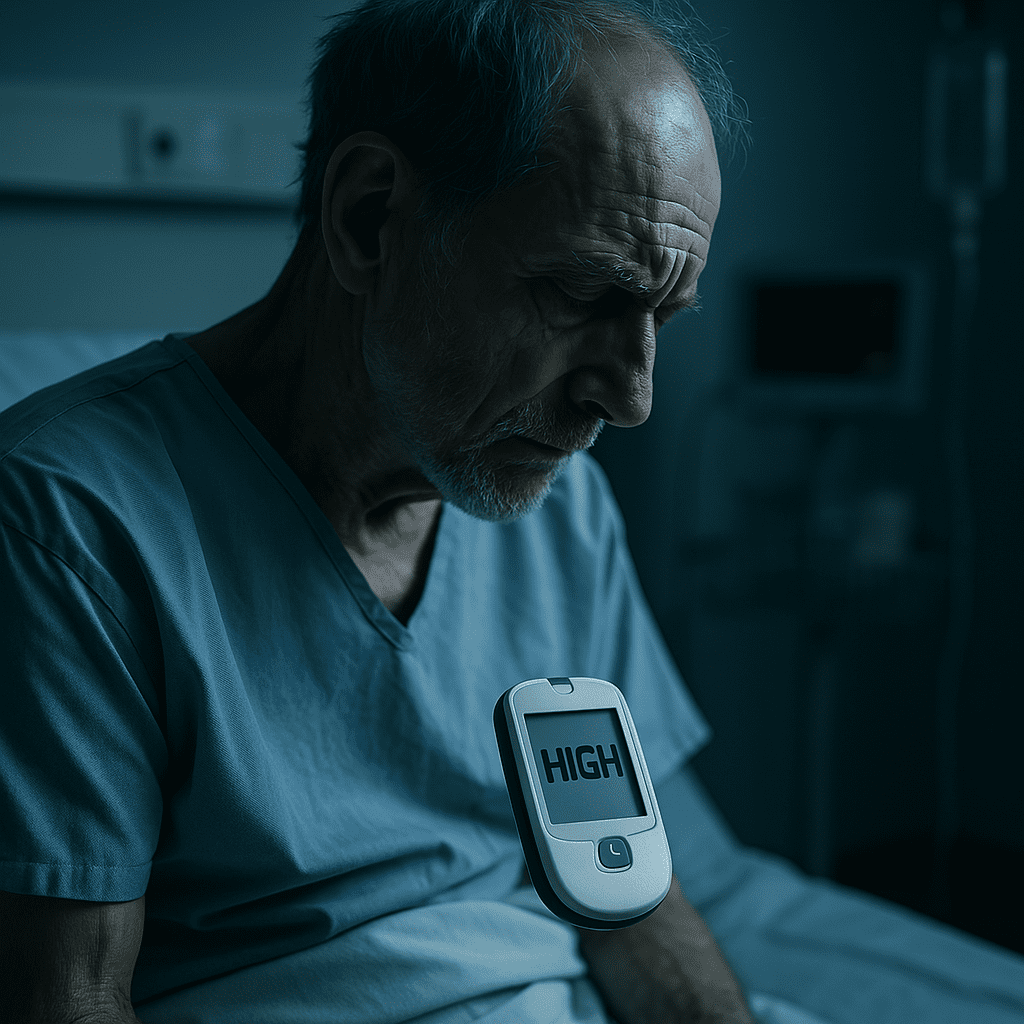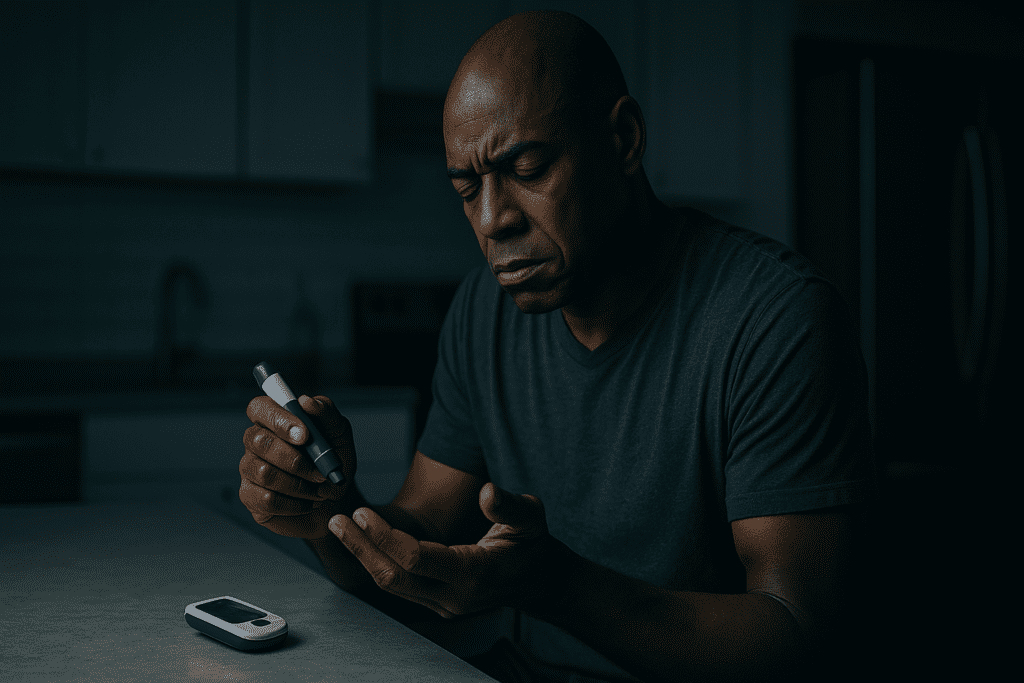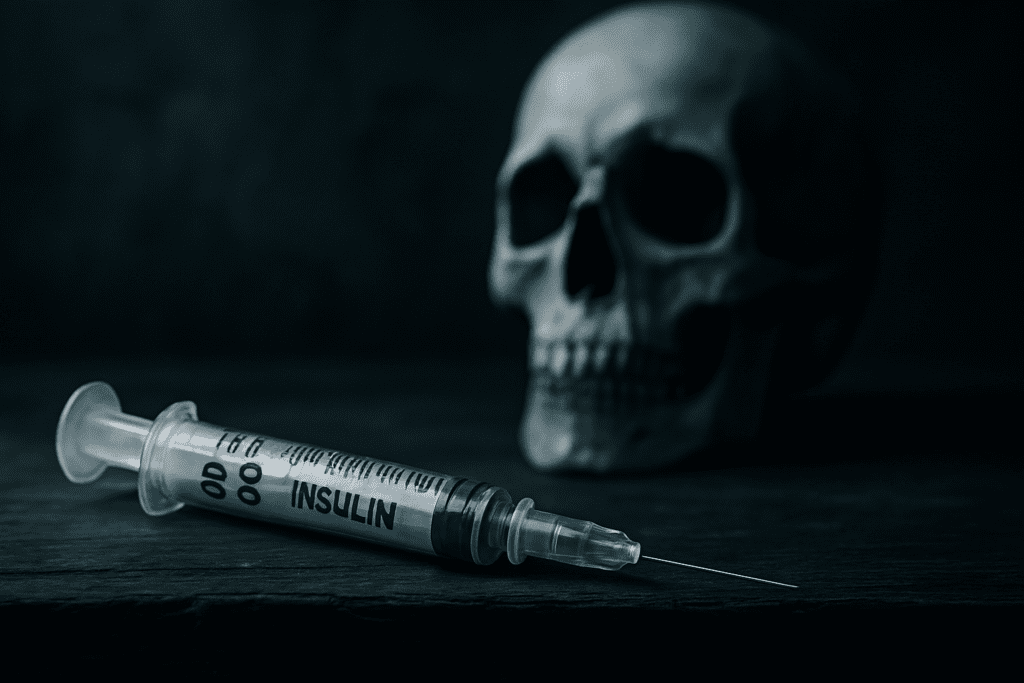When we consider chronic diseases that shape global health outcomes, diabetes stands prominently among the most pressing. Its growing prevalence across demographics, fueled by sedentary lifestyles and increasingly processed diets, underscores the urgency of understanding its full impact. But beyond the manageable daily routines of glucose monitoring and medication, many wonder: can diabetes kill you? While the early stages of diabetes may seem manageable with proper care, the long-term effects of poorly controlled blood sugar are far more serious and can lead to deadly complications. By the time one reaches the last stages of diabetes before death, the body is often in a critical state, overwhelmed by cumulative damage to vital organs. In this comprehensive exploration, we delve deep into what science reveals about the fatal potential of diabetes, particularly the risks associated with late-stage complications and mortality.
You may also like: How Diabetes Affects the Brain: Understanding Brain Fog, Memory Loss, and Mental Confusion from High Blood Sugar
Understanding Diabetes: Types and Mechanisms of Harm
Before addressing whether diabetes can kill you, it’s crucial to understand the disease’s two primary forms—Type 1 and Type 2. Type 1 diabetes is an autoimmune condition where the immune system attacks insulin-producing beta cells in the pancreas. This leads to an absolute deficiency of insulin, necessitating lifelong insulin therapy. Type 2 diabetes, by contrast, is characterized by insulin resistance and often develops gradually over time, particularly in individuals with genetic predispositions, obesity, or poor dietary habits.
Both types of diabetes disrupt the body’s ability to manage glucose, a vital energy source. When blood sugar levels remain chronically elevated—a condition known as hyperglycemia—this causes long-term damage to blood vessels, nerves, and organs. Over time, this damage accumulates, setting the stage for the late-stage complications that can ultimately lead to death. Recognizing the gravity of these biological changes is essential to understanding how high blood sugar can go before death becomes a real risk. While death from diabetes is not inevitable, without careful management, it becomes a legitimate and deeply concerning possibility.

The Insidious Progression Toward Late-Stage Complications
The early signs of diabetes may seem manageable—fatigue, increased thirst, and frequent urination are inconvenient, but rarely perceived as life-threatening. However, as diabetes progresses, especially when left uncontrolled, the internal toll becomes far more severe. The last stages of diabetes before death are often marked by complications such as advanced kidney disease (diabetic nephropathy), cardiovascular failure, blindness, and diabetic neuropathy.
In these final phases, the body often suffers from multiple overlapping dysfunctions. For instance, poorly controlled diabetes can lead to critical ischemia, where narrowed arteries fail to deliver oxygen-rich blood to tissues. This increases the risk of gangrene and amputations. Furthermore, elevated glucose levels weaken immune function, leaving the body vulnerable to infections that can rapidly escalate. Sepsis, pneumonia, and skin infections become not only more likely but more dangerous. These are some of the key signs that diabetes is killing you—not necessarily because of hyperglycemia alone, but because of how it gradually dismantles the body’s defenses.
Cardiovascular Disease: The Silent Killer in Diabetes
Perhaps the most insidious complication associated with diabetes is cardiovascular disease. Research consistently shows that individuals with diabetes are two to four times more likely to develop heart disease or experience a stroke than those without. This is not merely a correlation but a reflection of the complex metabolic disruptions diabetes introduces. Over time, high blood sugar damages the endothelium, the inner lining of blood vessels, promoting atherosclerosis—the buildup of plaque that narrows and hardens arteries.
Eventually, this can lead to myocardial infarction (heart attack), congestive heart failure, or stroke. In fact, the majority of people who die from diabetes-related causes succumb to heart disease. This reality adds urgency to the question: does diabetes kill you directly, or does it do so by setting the stage for other fatal conditions? In most cases, the answer is both. Cardiovascular decline is often the tipping point in the cascade of late-stage complications, and it exemplifies how diabetes can be a silent yet lethal force.
Kidney Failure and the Final Decline
Diabetic nephropathy, or diabetes-induced kidney disease, is another critical contributor to mortality. The kidneys serve as the body’s filtration system, eliminating waste and maintaining electrolyte balance. Chronic hyperglycemia can scar the tiny blood vessels in the kidneys, progressively reducing their function. When kidney damage becomes irreversible, patients enter end-stage renal disease (ESRD), requiring dialysis or kidney transplantation.
Many patients with ESRD experience an overwhelming physical and emotional burden. Dialysis, though life-sustaining, is not a cure. It often results in fluctuating blood pressure, fatigue, and a diminished quality of life. Without access to dialysis or a transplant, ESRD is a death sentence. These realities vividly illustrate how the question “can sugar diabetes kill you” is not theoretical—it’s a lived experience for many, particularly in underserved or resource-limited communities. As kidney function wanes, so does the body’s ability to regulate fluids, remove toxins, and maintain homeostasis—an inevitable march toward mortality.
Diabetic Ketoacidosis and Hyperosmolar Syndrome: Acute Killers
While many of the complications associated with diabetes progress gradually, there are also acute conditions that can lead to death in a matter of hours if not treated promptly. Diabetic ketoacidosis (DKA) primarily affects individuals with Type 1 diabetes and results from a severe lack of insulin. In DKA, the body begins breaking down fat for energy, producing ketones as a byproduct. When these ketones accumulate in the blood, they make it dangerously acidic. This condition, if untreated, can result in cerebral edema, coma, or death.
Hyperosmolar hyperglycemic state (HHS) is a similar crisis more common in Type 2 diabetes. In HHS, blood sugar levels can soar well above 600 mg/dL, leading to severe dehydration, confusion, and loss of consciousness. This scenario starkly demonstrates how high blood sugar can go before death becomes imminent. Both DKA and HHS are medical emergencies, and without swift intervention—usually involving intravenous insulin and fluids—they can quickly become fatal. These conditions highlight the pressing reality that the answer to “can diabetes kill you” is not just a matter of long-term neglect, but also of acute, life-threatening crises.
Neuropathy and the Slow Collapse of Bodily Systems
Another pervasive complication in the last stages of diabetes before death is diabetic neuropathy, or nerve damage. This condition typically begins as tingling or numbness in the extremities but can evolve into complete loss of sensation. Over time, this can lead to serious injuries that go unnoticed, such as foot ulcers, which can become infected and require amputation.
Beyond peripheral nerves, diabetes can also affect the autonomic nervous system, disrupting heart rate regulation, digestive function, and bladder control. When the body can no longer manage these basic processes, quality of life deteriorates dramatically. In some cases, sudden cardiac death can occur due to silent myocardial infarctions, a known risk for individuals with autonomic neuropathy. The subtlety of these symptoms often masks the severity of the underlying damage, making it difficult to recognize the signs that diabetes is killing you until it is too late.
How Long Does Diabetes Take to Kill You?
This question is difficult to answer definitively, as the timeline varies widely depending on the type of diabetes, the age of onset, lifestyle factors, and the quality of medical care received. However, longitudinal studies have shown that poorly controlled diabetes can shorten lifespan by up to 10 years. While someone newly diagnosed may live for decades with proper treatment, someone with uncontrolled blood sugar and multiple complications may decline rapidly.
In general, the progression from diagnosis to death can be gradual and marked by intermittent crises. For individuals asking “how long does diabetes take to kill you,” it’s important to recognize that while the disease itself does not have a set expiration date, the cumulative impact of its complications often determines the final outcome. Factors such as consistent medical follow-ups, medication adherence, and lifestyle modifications can dramatically extend life expectancy and improve quality of life. Still, in the absence of intervention, the end stages of diabetes are often devastating.
The Psychological Burden and Quality of Life in End-Stage Diabetes
The emotional and psychological toll of living with diabetes, especially in its final stages, cannot be overstated. Depression, anxiety, and diabetes distress—an emotional state of feeling overwhelmed by the demands of managing the disease—are common. These mental health challenges can interfere with treatment adherence and exacerbate physical symptoms, creating a vicious cycle.
As complications mount and the risk of mortality increases, patients may feel hopeless, isolated, or even resigned to their fate. For caregivers and family members, watching a loved one succumb to the consequences of diabetes can be heartbreaking. Understanding this emotional dimension is essential when considering whether diabetes will kill you—not just in a physical sense, but in how it impacts the entire being. Emotional support, counseling, and integrated care are vital components of managing late-stage diabetes effectively.
Preventing Death from Diabetes: What the Science Recommends
Despite the grim outlook in uncontrolled cases, diabetes is far from a death sentence. Advances in medical science, from continuous glucose monitors to personalized medication regimens, have transformed diabetes management. The key lies in early detection, education, and sustained lifestyle changes. Regular physical activity, balanced nutrition, and stress management can significantly mitigate the risk of severe complications.
For those asking “can type 2 diabetes kill you,” the answer is conditional: it can, but it doesn’t have to. With the right interventions, including medications like metformin, GLP-1 receptor agonists, and SGLT2 inhibitors, patients can maintain near-normal blood glucose levels and prevent or delay the onset of complications. Patient education plays a central role here—knowing how to recognize signs of trouble and understanding when to seek help can be lifesaving. Ultimately, the goal is to shift the narrative from one of inevitability to one of proactive empowerment.
Scientific Consensus on Diabetes and Mortality Risk
The epidemiological data paints a clear picture: diabetes significantly increases the risk of premature death. According to the World Health Organization, diabetes is among the top ten leading causes of death globally. The Centers for Disease Control and Prevention (CDC) reports that adults with diabetes are more likely to die from all causes than those without the condition. This heightened mortality risk is due not only to direct effects like ketoacidosis or renal failure but also to comorbid conditions that diabetes exacerbates, such as hypertension, obesity, and dyslipidemia.
Moreover, disparities in healthcare access, socioeconomic status, and education further compound the risks. In many underserved communities, the question “could diabetes kill you” is met not with speculation, but with lived experience. Bridging these gaps through public health initiatives, culturally competent care, and affordable medication is essential for reducing diabetes-related mortality worldwide. The science is unequivocal: without intervention, diabetes is a formidable threat to life.
Reframing the Narrative: Living Fully with Diabetes
While the medical facts surrounding diabetes and its mortality risk are sobering, it is equally important to highlight the potential for a fulfilling life despite the diagnosis. Innovations in diabetes care, coupled with greater public awareness and support systems, offer hope. From mobile health apps that track glucose trends to community-based programs that encourage healthy eating, the tools to fight back against diabetes are more accessible than ever.
Personal stories abound of individuals who, after asking “can diabetes kill you,” chose to rewrite their destinies. These stories often involve radical changes—embracing whole-food diets, taking up walking or yoga, engaging with diabetes support groups, and advocating for others. In doing so, they demonstrate that while diabetes is a chronic condition, it need not be a terminal one. Life with diabetes can still be rich, purposeful, and joyful when approached with the right knowledge, support, and resolve.

Frequently Asked Questions: The Final Stages of Diabetes and Mortality Risks
1. What are lesser-known signs that diabetes may be becoming life-threatening?
While classic symptoms like weight loss, fatigue, and infections are widely known, lesser-discussed signs that diabetes is killing you include increasing apathy, unhealed skin ulcers, gastrointestinal distress, and erratic cognitive functioning. These symptoms can indicate organ failure, often seen in the last stages of diabetes before death. At this point, damage to the kidneys, heart, and nervous system is typically irreversible. Some individuals may also experience persistent nausea or shortness of breath, often mistaken for other conditions. These subtle signs can signal that diabetes is killing you gradually, and without aggressive medical intervention, it can lead to rapid deterioration.
2. Can diabetes kill you suddenly, or is death usually a slow process?
Both outcomes are medically documented. While many wonder, “can diabetes kill you overnight?” it’s more common for complications to develop over time. However, in rare instances, diabetic ketoacidosis or severe hypoglycemia can cause coma and death within hours. Knowing how high blood sugar can go before death is crucial—levels above 600 mg/dL in hyperosmolar hyperglycemic states are especially dangerous. For those in the last stages of diabetes before death, the decline is usually more prolonged, marked by repeated hospitalizations and multisystem organ failure. So yes, diabetes can kill you slowly or suddenly, depending on how it progresses and how well it’s managed.
3. How long does diabetes take to kill you if left unmanaged?
This varies dramatically depending on the type, onset age, and lifestyle factors. In some individuals, it may take decades; in others, particularly those with undiagnosed or poorly controlled disease, the timeline may be much shorter. Asking “how long does diabetes take to kill you” is more than a statistical inquiry—it’s about recognizing the cumulative damage caused by chronic glucose toxicity. Neuropathy, retinopathy, and cardiovascular disease silently build up over time, eventually contributing to the last stages of diabetes before death. Without routine screenings and proactive treatment, diabetes can kill you faster than many expect, especially if compounded by obesity, smoking, or hypertension.
4. What are the emotional and psychological signs that someone is nearing the end stages of diabetes?
Emotional shifts—like apathy, social withdrawal, or a marked change in personality—are overlooked but common indicators. These are not simply mood issues; they can reflect the systemic burden of the disease on the brain and body. When asking, “does diabetes kill you physically only?” it’s critical to recognize that mental deterioration is also part of the equation. People in the last stages of diabetes before death may show signs of dementia-like confusion or even depression-induced psychosis. These cognitive declines are warning signs that diabetes is killing you in more ways than one—psychologically, socially, and biologically.
5. Can sugar diabetes kill you even if you’re not insulin-dependent?
Yes, sugar diabetes can kill you even without insulin dependency, especially in type 2 diabetes. The misconception that only insulin users are at risk is dangerous. Many adults assume type 2 is “milder,” but complications like stroke, heart attack, and kidney failure are just as fatal. The question “can type 2 diabetes kill you?” has a sobering answer: absolutely, particularly if blood sugar remains uncontrolled. In fact, non-insulin users are sometimes less vigilant about monitoring, which may allow silent damage to progress to the last stages of diabetes before death unnoticed.
6. How do you die from diabetes if your blood sugar is controlled?
It’s possible to maintain seemingly “normal” glucose levels and still face severe complications. For instance, someone with well-controlled glucose may still experience silent atherosclerosis or cardiac autonomic neuropathy. These can lead to sudden cardiac death, demonstrating that diabetes can kill you through underlying vascular or nerve damage. Asking “how do you die from diabetes if you’re managing it?” reveals an unsettling truth: numbers aren’t the whole story. Long-term inflammation and oxidative stress, even with decent A1C readings, can quietly push the body toward the last stages of diabetes before death.
7. Are there social or financial factors that increase the risk of diabetes-related death?
Absolutely. Those with limited access to healthcare, nutritious food, or proper education are far more vulnerable. Even if you ask, “could diabetes kill you in a developed country?” the answer is yes—especially among marginalized populations. Poorer patients may delay care, skip medications, or miss signs that diabetes is killing you. Systemic barriers and social determinants of health often push patients into the last stages of diabetes before death without the resources to reverse course. So yes, sugar diabetes can kill you faster in the absence of stable housing, health insurance, or community support.
8. What happens to the organs in the final stage of diabetes?
In the last stages of diabetes before death, multiple organs begin to fail—most notably the kidneys, heart, eyes, and brain. Diabetic nephropathy can evolve into end-stage renal disease, often requiring dialysis. The heart may suffer silent ischemia or failure due to years of microvascular damage. Asking “how high can blood sugar go before death?” underscores how hyperglycemia pushes these systems beyond repair. Even the pancreas itself may lose its final ability to produce insulin, worsening the crisis. So yes, diabetes can kill you organ by organ, often silently, until one failure tips the balance.
9. Is it possible to reverse the fatal trajectory once signs of terminal diabetes appear?
In rare cases, aggressive and immediate interventions—like hospitalization, dialysis, or intensive insulin therapy—may extend life. But once someone reaches the last stages of diabetes before death, full reversal is unlikely. That said, comfort care, palliative planning, and dignity in dying become more important than aggressive medical management. Asking “will diabetes kill you once you’re in the end stage?” often means preparing for death, not escaping it. Still, some may find meaningful months or years with the right medical and emotional support, even in late-stage disease.
10. What preventative lessons can be learned from diabetes-related deaths?
The greatest lesson is that early detection and consistent management save lives. If someone has ever asked, “can you die from diabetes if you’re under 40?” the answer is yes—but it’s also often preventable. Understanding the subtle early warnings can stop the cascade that leads to the last stages of diabetes before death. Recognizing that diabetes can kill you if it’s normalized or ignored is a cultural wake-up call. Public health education must go beyond “eat less sugar” to include how high blood sugar can go before death, why silent symptoms matter, and how to advocate for aggressive care.

A Sobering Reality, A Call to Action: Final Thoughts on Diabetes and Mortality Risk
As we reflect on the many dimensions of diabetes—from its biological intricacies to its life-altering complications—the answer to “can diabetes kill you” becomes painfully clear: it can, and it does. However, this does not mean that a diagnosis of diabetes should be met with despair. Rather, it should serve as a call to action—for individuals, healthcare systems, and society at large.
Recognizing the signs that diabetes is killing you, such as unhealed wounds, chronic fatigue, or extreme blood sugar fluctuations, can prompt timely intervention. Knowing how high blood sugar can go before death is a risk provides a critical threshold for medical urgency. Understanding how you die from diabetes—the combination of organ failure, cardiovascular collapse, or sepsis—can offer insights into prevention.
Ultimately, whether diabetes will kill you depends on a complex interplay of biology, behavior, environment, and healthcare access. But with awareness, dedication, and science-backed strategies, many of its deadliest outcomes are preventable. Let this be not just an article, but a catalyst for deeper reflection, timely action, and a collective commitment to transforming the trajectory of diabetes—so that fewer lives end in its final, irreversible stages.
diabetes and cardiovascular risk, chronic illness mortality, blood sugar emergencies, late-stage diabetes care, diabetic organ failure, glucose management strategies, insulin resistance treatment, diabetic complications prevention, blood sugar monitoring tools, diabetes and kidney disease, diabetic neuropathy symptoms, health outcomes in type 2 diabetes, lifestyle changes for diabetes, endocrine system disorders, managing hyperglycemia, diabetes-related infections, diabetes education programs, metabolic syndrome insights, public health and diabetes, preventing diabetes-related death
Further Reading:
The burden and risks of emerging complications of diabetes mellitus
Diabetes Mellitus and Cause-Specific Mortality: A Population-Based Study
Disclaimer: The content published on Better Nutrition News (https://betternutritionnews.com) is for informational and educational purposes only. It is not intended as a substitute for professional medical advice, diagnosis, or treatment. Always seek the guidance of a qualified healthcare professional before making any changes to your diet, nutrition, or wellness practices. The opinions expressed by authors and contributors are their own and do not necessarily reflect those of Better Nutrition News.
Better Nutrition News and its affiliates make no representations or warranties regarding the accuracy, completeness, or reliability of the information provided. We disclaim all liability for any loss, injury, or damage resulting from the use or reliance on the content published on this site. External links are provided for reference purposes only and do not imply endorsement.



